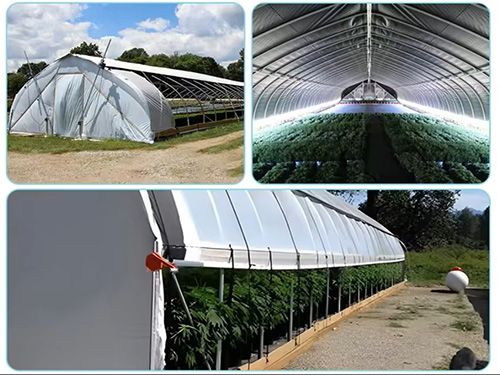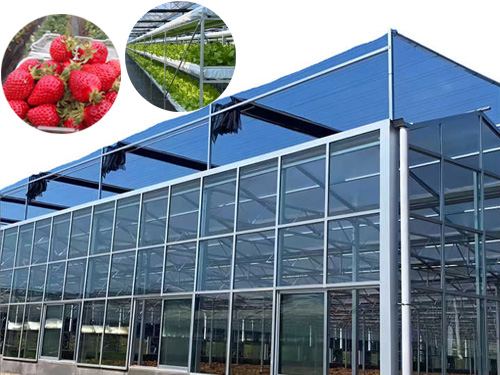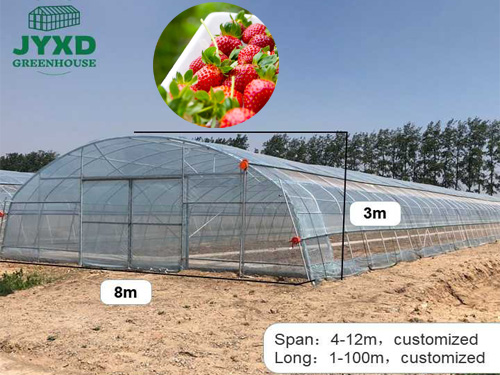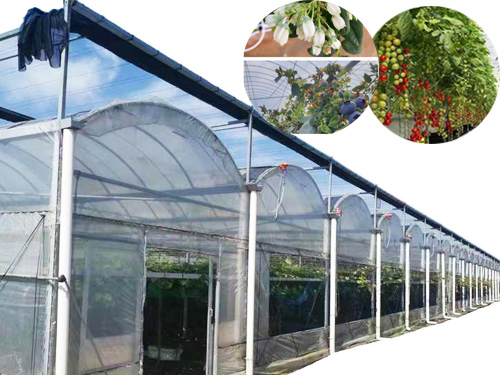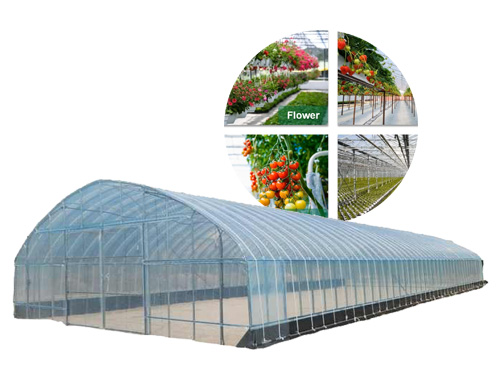NEWS DETAILS
NEWS INFORMATION
Organic Farming in Greenhouses: Pesticide-Free and Fertilizer-Free Solutions
AUTHOR:jyxd-greenhouse DATE:2025-01-20 17:02:51 HITS:116
Organic farming is gaining increasing popularity as consumers become more conscious of the impact of conventional agriculture on both health and the environment. Greenhouses provide an ideal environment for organic farming, allowing growers to control environmental factors while adhering to organic practices. In this article, we will explore the principles of organic farming in greenhouses, focusing on pesticide-free and fertilizer-free solutions that support sustainable farming practices and produce high-quality crops.
What Is Organic Farming in Greenhouses?
Organic farming in greenhouses is a method of growing crops without the use of synthetic pesticides, fertilizers, or genetically modified organisms (GMOs). It emphasizes the use of natural resources, biological processes, and ecological balance to maintain soil health, control pests, and improve crop production. Greenhouses offer several advantages for organic farming, including the ability to control temperature, humidity, and light levels, which leads to enhanced crop yields and healthier plants.
The main goal of organic farming in greenhouses is to produce crops that are free from harmful chemicals while promoting sustainability. This can be achieved through innovative techniques that avoid the need for synthetic pesticides and fertilizers, focusing on natural alternatives that support a healthy growing environment.
Benefits of Organic Farming in Greenhouses
Organic farming in greenhouses offers several benefits over conventional methods. These include:
1. Healthier Crops and Consumers
Organic crops are grown without synthetic chemicals, meaning they are free from pesticide residues and chemical fertilizers that may be harmful to human health. This makes organic produce a safer and healthier option for consumers.
2. Environmental Sustainability
By avoiding synthetic chemicals, organic farming reduces the risk of soil and water contamination. Additionally, it promotes biodiversity and the health of ecosystems. Greenhouses allow for more efficient use of resources, such as water and energy, and can contribute to more sustainable farming practices.
3. Higher Market Demand
The growing consumer demand for organic produce has created a lucrative market for farmers who choose to adopt organic farming practices. Organic produce often commands higher prices in the marketplace, making it a profitable venture for growers.
4. Reduced Pest Resistance and Disease Control
By focusing on natural pest management strategies and promoting healthy soil, organic farming helps reduce the development of pest resistance, which is a common issue with chemical pesticides in conventional farming. This leads to a more sustainable and long-term solution for pest control.
Pesticide-Free Solutions in Organic Greenhouses
One of the main challenges of organic farming is controlling pests and diseases without resorting to synthetic chemicals. In greenhouses, pest control is especially important because the enclosed environment can make it easier for pests to spread quickly. Here are some effective, pesticide-free solutions for managing pests in organic greenhouses:
1. Integrated Pest Management (IPM)
Integrated Pest Management (IPM) is an essential strategy in organic farming. It combines biological, physical, cultural, and mechanical methods to manage pest populations in a way that minimizes environmental impact. Some key components of IPM include:
· Biological Control: Using natural predators or beneficial insects to control pest populations. For example, ladybugs can help control aphids, while nematodes can target soil-dwelling pests.
· Cultural Practices: Adjusting planting practices, such as crop rotation, intercropping, or companion planting, to disrupt pest life cycles and prevent infestations.
· Physical Barriers: Using mesh or row covers to physically prevent pests from accessing crops while allowing light and air to circulate.
2. Natural Pesticides
When necessary, organic growers can use natural pesticides that are derived from plants, minerals, or microorganisms. These natural solutions are less harmful to the environment and beneficial insects compared to synthetic pesticides. Examples of natural pesticides include:
· Neem Oil: Derived from the neem tree, this oil is effective against a wide range of pests, including aphids, spider mites, and whiteflies.
· Diatomaceous Earth: A fine powder made from the fossilized remains of diatoms, which can be used to control soft-bodied insects by damaging their exoskeletons.
· Insecticidal Soap: Made from fatty acids, this soap can be sprayed directly onto plants to control aphids, mealybugs, and other pests.
3. Beneficial Microorganisms
Microorganisms like bacteria, fungi, and nematodes can be used to control pests and diseases in organic greenhouses. These beneficial microorganisms work by either attacking pests directly or outcompeting harmful pathogens in the soil.
· Bacillus thuringiensis (Bt): This naturally occurring bacterium targets and kills specific pests, such as caterpillars and beetles, without harming other insects.
· Trichoderma spp.: These fungi can be used to control root rot diseases caused by soil-borne pathogens.
· Mycorrhizal Fungi: These fungi enhance plant growth and help plants resist pests and diseases by promoting a healthy root system.
Fertilizer-Free Solutions in Organic Greenhouses
In organic farming, fertilizers are often replaced with natural alternatives to provide plants with the necessary nutrients for growth. Greenhouses offer a controlled environment that makes it easier to manage soil health without relying on synthetic fertilizers. Here are some fertilizer-free solutions used in organic greenhouses:
1. Composting
Composting is an excellent way to create nutrient-rich soil without the need for synthetic fertilizers. By recycling organic materials like plant residues, kitchen scraps, and animal manure, farmers can produce high-quality compost that enhances soil fertility and supports healthy plant growth.
· Compost Tea: A liquid version of compost, compost tea is made by steeping compost in water. It can be used to provide plants with essential nutrients and beneficial microorganisms.
2. Cover Cropping
Cover cropping involves planting certain crops between main growing seasons to improve soil health. These cover crops, such as clover, legumes, and rye, help fix nitrogen in the soil, improve soil structure, and suppress weeds. The organic matter from cover crops can also be incorporated back into the soil to enhance its nutrient content.
3. Vermiculture (Worm Farming)
Vermiculture is the process of using worms, particularly red wigglers, to break down organic matter into nutrient-rich worm castings, also known as vermicompost. Worm castings are an excellent natural fertilizer that can improve soil structure and provide plants with essential nutrients. They are often used in organic greenhouses to reduce the need for chemical fertilizers.
4. Green Manures
Green manures are fast-growing crops that are grown specifically to be tilled back into the soil to improve its fertility. Legumes, such as beans and peas, are particularly beneficial because they fix nitrogen in the soil, which plants need for healthy growth.
Conclusion
Organic farming in greenhouses provides a sustainable solution to growing high-quality crops without relying on synthetic pesticides or fertilizers. By using pesticide-free solutions such as integrated pest management, natural pesticides, and beneficial microorganisms, greenhouse farmers can effectively control pests while minimizing environmental impact. Fertilizer-free alternatives like composting, cover cropping, and vermiculture promote soil health and reduce dependence on chemical inputs. Together, these methods contribute to the long-term success of organic greenhouse farming, producing crops that are healthier for both consumers and the planet.
Hebei Juyou Xinda Greenhouse Facilities Co.,Ltd.
Copyright © 2024-2025 https://www.jyxd-greenhouse.com. All Rights Reserved Hebei Juyou Xinda Greenhouse Facilities Co.,Ltd.Copyright





 Current Location:
Current Location:


